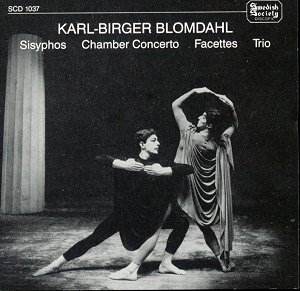Blomdahl became a student of Hilding Rosenberg
at the age of nineteen and reached international musical celebrity
with Facetter, his Third Symphony in 1950. The excellent
recording of it here dates from eight years after the premiere
and is part of a fine, wide-ranging conspectus of Blomdahl’s compositional
breadth, taking in a trio, chamber concerto and two pieces from
his ballet Sisyphos.
Opening with Sisyphos we are immediately introduced
to his often granitic and binary writing. These two Dances, the
Dance with Death – grimly and insistently interjectory – and the
Dance of Life - intensely rhythmic, propelled by jazzy rhythms
with far-flung winds and brute trombones and scurrying percussion
– both show his instrumental command. The Chamber Concerto, a
quarter of an hour work for piano, woodwind, percussion and orchestra,
can be brusque but also contains moments of reflection and also
unease. In three fairly obvious sections the second has a dramatically
rhythmic drive and the third section is very much more interior
and wounded.
The Symphony sounds splendid in this restoration.
It’s a fast moving twelve tone variation form piece that shows
exceptional invention in its layering of string textures. The
brass is ringingly defiant, indeed remorseless, and there’s incremental
hieraticism and complex development. It’s only with the solo flute’s
lone impress that we hear the reintensification of those swirling
strings, gaunt and impassive, and the blocks of brass. Blomdahl
is however at his most lyrical and reflective, appositely enough,
in the Trio. Though the lyric scraps of the first movement never
settle, the slow movement witnesses some elliptical clarinet,
ghostly cello and the shudder of the piano’s treble. After the
scurrying and restless Allegro giocoso it’s the cumulatively affecting
finale that sees the cello’s increasingly explicit lyricism followed
by the clarinet; the whole ends in elliptical stillness, a trajectory
that feels entirely right, impressively pointed and achieved.
It’s the most immediately attractive of the works here – probably
also the most subtle as well in its sense of accumulation and
disposition of material.
Notes are brief but apposite and the remastering
unobtrusively excellent. Blomdahl can sometimes be something of
a hard nut to crack but his lyrical impulse is always attractive
and sympathetic.
Jonathan Woolf
